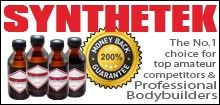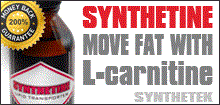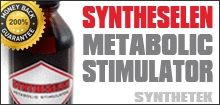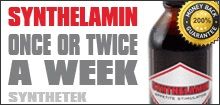You are using an out of date browser. It may not display this or other websites correctly.
You should upgrade or use an alternative browser.
You should upgrade or use an alternative browser.
The HORIZONTAL SHRUG exercise to GROW the FULL TRAPEZIUS
- Thread starter Type-IIx
- Start date
- Joined
- Mar 3, 2024
- Messages
- 1,505
Will give this a try next back day just to see how it feelsTHE HORIZONTAL SHRUG
A new exercise that ACTUALLY GROWS the FULL TRAPEZIUS
You touched on the traps being a mostly fast twitch muscle group. Would you be able to touch on all the different muscle groups and whether they're predominantly fast or slow twitch? In addition to being good content, it could help if we orient our training to appeal to the types of fibers were trying to recruit
- Joined
- Mar 17, 2020
- Messages
- 581
I shrug standing upright and at a 45 degree also chest supported. Guess it’s kinda the same thing. Traps fire from different angles. Thanks for the vid.
- Joined
- Aug 6, 2023
- Messages
- 357
Interesting - thoughts on the Kelso shrug?
Sure. Now, to be clear, there are fast-twitch fibres contained across all the muscle groups, and these fibers have the most growth potential. The expression of slow (e.g., type IA) muscle isoforms versus fast (e.g., type IIA/B/X) is under partly genetic control but is also amenable to training influence. Transitions from faster to slower isoform expression is possible (training for endurance qualities, for example), and vice versa as well, with type IIX fibres, the fastest, most glycolytic, least aerobic isoform in humans, serving as a sort of reserve fibre that is the most glycolytic, most fatiguable, most forceful and fastest type, with unloading.Will give this a try next back day just to see how it feels
You touched on the traps being a mostly fast twitch muscle group. Would you be able to touch on all the different muscle groups and whether they're predominantly fast or slow twitch? In addition to being good content, it could help if we orient our training to appeal to the types of fibers were trying to recruit
Speaking from a teleological perspective of conserved evolution, generally, the muscle groups that are responsible for maintaining an upright torso and basic locomotion, and for long hunts on foot, or for foraging tasking, tend to be the slow twitch groups, e.g., the erector spinae (standing upright on two feet), the abdominals and obliques (standing upright, twisting, bending, stooping), the soleus of the calves (walking long distances) along with the Achilles complex. This is because they need endurance, to be fatigue resistant.
The fast twitch fibres are those needed for "fighting" or "fleeing," generally, for example the trapezius (yanking/pulling), the hamstrings (jumping), punching (triceps), and these examples of conserved evolution go down to the motor unit, cellular, and probably subatomic level.
The setup is usually a bitch, but when you get your configuration right and you get used to it, I am 100% positive you'll like this exercise cause it's an incredible difference vs. dumbbell shrugs.Will give this a try next back day just to see how it feels
You touched on the traps being a mostly fast twitch muscle group. Would you be able to touch on all the different muscle groups and whether they're predominantly fast or slow twitch? In addition to being good content, it could help if we orient our training to appeal to the types of fibers were trying to recruit
- Joined
- Mar 3, 2024
- Messages
- 1,505
Ahh so that's where the username comes from. It all makes sense nowSure. Now, to be clear, there are fast-twitch fibres contained across all the muscle groups, and these fibers have the most growth potential. The expression of slow (e.g., type IA) muscle isoforms versus fast (e.g., type IIA/B/X) is under partly genetic control but is also amenable to training influence. Transitions from faster to slower isoform expression is possible (training for endurance qualities, for example), and vice versa as well, with type IIX fibres, the fastest, most glycolytic, least aerobic isoform in humans, serving as a sort of reserve fibre that is the most glycolytic, most fatiguable, most forceful and fastest type, with unloading.
Speaking from a teleological perspective of conserved evolution, generally, the muscle groups that are responsible for maintaining an upright torso and basic locomotion, and for long hunts on foot, or for foraging tasking, tend to be the slow twitch groups, e.g., the erector spinae (standing upright on two feet), the abdominals and obliques (standing upright, twisting, bending, stooping), the soleus of the calves (walking long distances) along with the Achilles complex. This is because they need endurance, to be fatigue resistant.
The fast twitch fibres are those needed for "fighting" or "fleeing," generally, for example the trapezius (yanking/pulling), the hamstrings (jumping), punching (triceps), and these examples of conserved evolution go down to the motor unit, cellular, and probably subatomic level.
And I appreciate the detailed reply bro, this was incredibly helpful and easy to understand.
You have a great mind. Looking forward to future content
It's a coupled dynamic + isometric for the trapezius and rhomboids. These complexes build very little muscle during the isometric phase since they're submaximal, and isometrics generally do not stimulate muscle damage/hypertrophy.Interesting - thoughts on the Kelso shrug?
If the isometric phase was, instead of the Kelso shrug, done as a maximal pull at various heights into an immovable object, i.e., loaded maximally as MVIC, maximal voluntary isometric contractions, then you might get somewhere!
Suffice it to say, I think the Kelso shrug is pretty dumb.
It's not the same thing! Changing torso positions doesn't change gravity's pointing down.I shrug standing upright and at a 45 degree also chest supported. Guess it’s kinda the same thing. Traps fire from different angles. Thanks for the vid.
- Joined
- Jan 19, 2013
- Messages
- 772
Didn’t watch the video and I love doing Kelso shrugs when I do train traps. Either with dumbbells on an incline bench or using a chest supported T-bar rowInteresting - thoughts on the Kelso shrug?
I had to stop training traps a while ago. Got too ridiculous and looked like a frog
- Joined
- Aug 6, 2023
- Messages
- 357
Tried your version this morning, definitely cooked my trapsIt's a coupled dynamic + isometric for the trapezius and rhomboids. These complexes build very little muscle during the isometric phase since they're submaximal, and isometrics generally do not stimulate muscle damage/hypertrophy.
If the isometric phase was, instead of the Kelso shrug, done as a maximal pull at various heights into an immovable object, i.e., loaded maximally as MVIC, maximal voluntary isometric contractions, then you might get somewhere!
Suffice it to say, I think the Kelso shrug is pretty dumb.
- Joined
- Oct 10, 2021
- Messages
- 201
I do chest supported also.I shrug standing upright and at a 45 degree also chest supported. Guess it’s kinda the same thing. Traps fire from different angles. Thanks for the vid.
Line an incline bench over the top of a smith machine bar, so it's positioned under my shoulder. Feels great and deffo noticed more thickness from the back as opposed to the height of traps.
Chest-supported (at ~ 45-deg) does work better than standing for sure since the trapezius' function is not merely scapular elevation but retraction as well.I do chest supported also.
Line an incline bench over the top of a smith machine bar, so it's positioned under my shoulder. Feels great and deffo noticed more thickness from the back as opposed to the height of traps.
- Joined
- Oct 10, 2021
- Messages
- 201
I'll be giving your way a go when I'm doing back and traps on Saturday... Nice oneChest-supported (at ~ 45-deg) does work better than standing for sure since the trapezius' function is not merely scapular elevation but retraction as well.
- Joined
- Apr 23, 2012
- Messages
- 3,032
I like them on the t bar or laying down on the seated cable row w the v handle.
Which variant, the seated row style configuration? Or the dumbbell one? The seated row style one is much less fucking about with configuration than the dumbbell one if you can do it.Tried your version this morning, definitely cooked my traps
- Joined
- Feb 21, 2008
- Messages
- 5,918
Watched Mike Van Wyck's trap video a while back. Used dumbells and leaned forward while lifting them up with bent arms a couple days ago. My traps are sore as I'm posting this.
- Joined
- Aug 6, 2023
- Messages
- 357
the seated row style - wasnt ready to look like a science experiment with the dumbbell cable set up lolWhich variant, the seated row style configuration? Or the dumbbell one? The seated row style one is much less fucking about with configuration than the dumbbell one if you can do it.
I find most people load up the bar and do short range partial shrugs herky jerky movement and don't pull back at all and don't come close to a full range. The traps work by pulling up and back. My favorite version in on something like a standing calf raise. I can get a full contraction with my shoulders up by my ears and back. I can feel them all the way down to the lower base of the traps.
- Joined
- Sep 19, 2022
- Messages
- 3
It's a coupled dynamic + isometric for the trapezius and rhomboids. These complexes build very little muscle during the isometric phase since they're submaximal, and isometrics generally do not stimulate muscle damage/hypertrophy.
If the isometric phase was, instead of the Kelso shrug, done as a maximal pull at various heights into an immovable object, i.e., loaded maximally as MVIC, maximal voluntary isometric contractions, then you might get somewhere!
Suffice it to say, I think the Kelso shrug is pretty dumb.
Not sure why you say this. What you've described and shown in the video is the Kelso shrug. The second exercise on the cables is more clear because there's one line of pull, but that's just the Kelso shrug using a cable machine.
Similar threads
Popular tags
aas
aas testing
anabolic steroids
anabolics online
anabolid steroids
anadrol
anadrol drol tabs inj
anavar
anavar and winnie
body building
body building supplements
bodybuilder
bodybuilding
bodybuilding steroid test
buy
buy la pharma steroids
buy masteron
clenbuterol
cycle
deal buy tabs free
deca tren dosage
deca-durobolin
dht gel buy
dianabol
dianabol and oxy
dragon pharma
gear
hcg
hgh
motivation
muscle building
muscle mass
nandrolone
pct
peptides
steroid cycle
steroids
suspension
sustanon
test
test 400
test cyp
test cypionate
test prop
testosterone
testosterone boosters
testosterone cypionate
tren ace
tren ace buy
trenbolone acetate
Popular tags
aas
aas testing
anabolic steroids
anabolics online
anabolid steroids
anadrol
anadrol drol tabs inj
anavar
anavar and winnie
body building
body building supplements
bodybuilder
bodybuilding
bodybuilding steroid test
buy
buy la pharma steroids
buy masteron
clenbuterol
cycle
deal buy tabs free
deca tren dosage
deca-durobolin
dht gel buy
dianabol
dianabol and oxy
dragon pharma
gear
hcg
hgh
motivation
muscle building
muscle mass
nandrolone
pct
peptides
steroid cycle
steroids
suspension
sustanon
test
test 400
test cyp
test cypionate
test prop
testosterone
testosterone boosters
testosterone cypionate
tren ace
tren ace buy
trenbolone acetate
Members online
- prodaf
- KingOfSushi
- Doitagain
- Lily.
- joeyliftss
- chainsaw
- Latenate
- Veneficus_Rex
- aDw32
- appealmaxed
- Simon90
- mr.a
- Siggy
- hawkmoon
- FakeName123
- Yourmuscleshop
- whoremoan
- traininsane11
- Paul.uns
- jasonhill800
- PhillD
- bgunner
- severniy
- notorius
- massephase
- Alfie9119
- Shaneyboy
- Shelby
- SB Labs
- mvdds
- MajinBoo
- BLUEDIAMOND
- Yousef12O2
- buzzbomb138
- Mia
- luki7788
- USAman
- Grizzly_Adams
- Wintermaul
- Maly
- DecaForDessert
- ChefTren
- Mr OZ
- 2swolejoe17
- gordonnash18
- URODA
- Josefein421
- RawsAndGH
- carbs
- dudckdodger3
Total: 1,403 (members: 1,393, guests: 10)
Forum statistics
- Total page views
- 600,655,705
- Threads
- 140,953
- Messages
- 2,909,265
- Members
- 162,798
- Latest member
- Harry Balzonya




















































































